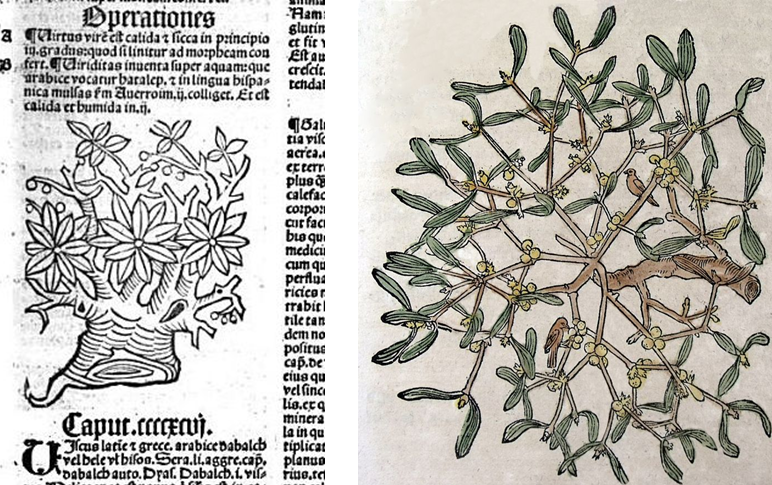The Mistletoe Walk
/The Mistletoe Walk
Mistletoe (Viscum album), the sacred plant of the Druids, has become embedded within our folklore, tradition and mythology, particularly at Christmas and New Year. On this festive themed walk we set off to discover more about this special sacred plant and to hopefully find a sprig for ourselves!
In the UK mistletoe generally confines itself to the south of England and west midlands. It is most obvious in the landscape during the winter months when the trees on which it grows have lost their summer foliage. Against the cold blue winter sky, its great spherical clumps (up to 1m wide) are prominent among the branches.
Here in the Chilterns mistletoe is locally abundant presenting a perfect opportunity for a festive themed walk and our annual Mistletoe Walk has now become a firm favourite in our walk programme!
Lime Trees Burdened with Mistletoe - Crowsley Park
“The trees, though summer, yet forlorn and lean, O’ercome with moss and baleful mistletoe.”
The walk, which starts in the south Oxfordshire village of Binfield Heath, is one which we are familiar with. From the village playground, where mistletoe can be seen high up in the lime trees (Tilia), we head out to the Bottle and Glass Inn and follow Bones Lane into the woods. The open parkland of Crowsley Park draws us in and here we find tall stands of lime trees burdened with many large clumps of mistletoe, some just within reach. Time for a few facts about this fascinating sacred plant!
Mistletoe Facts
Mistletoe Facts
The European mistletoe (Viscum album) is a hemi-parasitic evergreen shrub with pearly white berries throughout the winter. It relies on its host tree for support, water and some nutrients but it also has green leaves and is able to photosynthesise.
Host trees include hawthorn, blackthorn, poplar, lime and rowan, and most commonly apple. Rarely, is it found on oak.
Mistletoe is dioecious - male and female flowers are produced on separate plants. All parts of the plant are poisonous.
Mistletoe berries are a winter food for thrushes and blackcaps - the Mistle Thrush even derives its name from the plant.
Seeds are surrounded by sticky mucus that the birds wipe from their beaks on the branches of trees; some seeds get attached to the bark and root into the woody tissue. The seed is also spread by bird droppings.
Continuing on through the Park, we spot more mistletoe which has taken hold in some hawthorn (Crataegus monogyna) bushes. Our way leads up Kings Farm Lane and on past Upper House Farm towards Pond Copse. In past years we have gathered mistletoe from a large old hawthorn bush here but, alas, there is no life in it now and no mistletoe. Fortunately, however, plenty of mistletoe has now taken hold in the whitebeam trees (Sorbus aria) which line the path, and at just the right height to pick!
Folklore & Legend
Now, we can’t gather mistletoe without hearing a little mistletoe folklore and legend. The plant has been associated with love, peace, fertility and life-giving power, and protection from evil and witchcraft throughout the ages and in many cultures around the world.
Mistletoe in the Old Hawthorn Tree
In Britain we associate mistletoe with the Druids. Pliny the Elder recorded their use of it in his Natural History, 77 AD. To the Druids, mistletoe from the sacred oak tree was a magical medicinal plant to be harvested only with a golden sickle. They believed it would protect from evil and cure disease.
Mistletoe has become embedded within our folklore, tradition and mythology, particularly at Christmas and New Year. One of my favourites is a Norse Legend:
Mistletoe was the sacred plant of the Norse Goddess Frigg, goddess of love and destiny, wife of Odin and the mother of Baldr, the god of the summer sun.
Frigg became greatly concerned when Baldr had dreams of death, for should he die, all life on earth would end. She went in haste to air, fire, water, earth, and every animal and plant seeking a promise that no harm would come to her son. But Baldr had one enemy, Loki, god of evil and he knew of one plant that Frigg had overlooked in her quest to keep her son safe. It was mistletoe, growing neither on the earth nor under the earth, but on apple and oak trees.
Mistletoe in Whitebeam Tree
Loki made an arrow of the mistletoe and tricked Hoder, the blind god of winter and darkness, to throw it at Baldr striking him dead.
The sky dimmed and all things in earth and heaven wept for the sun god. The elements did all they could to bring Baldr back to life but he was finally restored by his mother Frigg, the goddess of love and destiny. The pearly white berries of the mistletoe were formed from the tears she shed for her son, and in her joy Frigg kissed everyone who passed beneath the tree on which it grew. Frigg decreed was that no harm should befall anyone who stands under the mistletoe, only a kiss as a token of love.
Mistletoe - an ‘All-Heal’
With a bag stuffed full with mistletoe it was time to walk on and return through the woods to the Bottle and Glass for some festive refreshment. Over a glass of the local Loddon Beer we learned that since Greek, Roman and Druidic time’s mistletoe has been used for nervous system disorders, including epilepsy. It had also had gained a reputation as an ‘all-heal’ to enhance fertility. Mistletoe thus featured in many of the great Herbals and Materia Medica.
The Great Herbals
Left: Mistletoe in an Oak tree - Jacob Meydenbach, Hortus Sanitatis, 1491
Right: Mistletoe - Hieronymus Bock, Kreutterbuch (or "herbal"), 1565
In 1720 Sir John Colbatch, investigated the effect of mistletoe on epilepsy. He published A Dissertation Concerning Mistletoe: A Most Wonderful Specifick Remedy for the Cure of Convulsive Distempers (1720) in which he wrote:
that there must be something extraordinary about that uncommon beautiful plant, that the Almighty had designed it for further and more noble uses than barely to feed thrushes or to be hung up superstitiously
In more recent times mistletoe extracts have been used in cancer therapy although it does not replace conventional treatments.
And finally… Poo Sticks!
Suitably refreshed we head back along the lane to the village playground. A final mistletoe fact before we depart… The word mistletoe comes from the Old English ‘mistiltan’, which is derived from the word ‘mistel’ meaning ‘dung’ and ‘tan’ meaning ‘twig’ (or poo stick!). The Latin name ‘viscum’ also means birdlime made from the berries of the European mistletoe. Something to remember when kissing under the mistletoe this festive season!
Discover more:
If you would like to experience this walk, or a similar inspired journey on foot, please get in touch. We would love to hear from you!





















